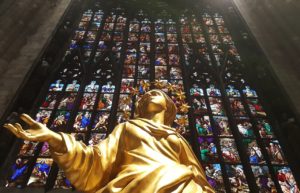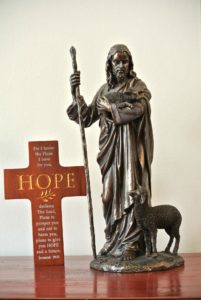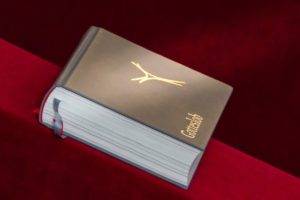Have you ever been to a church that claimed that the earth is young? Have you ever felt pressured into believing in a young earth, even though you felt the scientific evidence was contrary to a young earth? Have you ever thought that in order to be a Christian, you had to deny science, and believe in a young earth? You are not alone. Many churches preach that the earth is young, and many require you to profess this belief through their statement of faith, which includes a world that was created in six 24-hour days. No, you are definitely not alone…millions have been driven away from the church, and Christ, because of this very topic.
However, there is no need for this to happen. Yes, you can believe in an old earth, and become a Christian. Yes, the Word of God is without error, and its account of the creation story in Genesis is perfectly in line with the scientific record.
The doctrine of salvation has nothing to do with the age of the earth. The Bible does not say, “Believe in a young earth, or be condemned to hell.” You can become a Christian and believe in an old earth.
Want to learn more? This website is here to help you. Let’s start with a basic explanation of old-earth theology. There are several major positions one can take with regards to the old age of the earth and creation. With each position, you can believe in an inerrant Bible and a literal interpretation of Genesis. They are:
1. Progressive Creationism. In this theory, each day of creation is equated to a long period of time, and represents a specific portion of God’s creative work which may overlap the other days of creation.
Even though Progressive Creationists believe in an old earth, they do not believe in evolution, but rather that each species was created a unique creation, from nothing, without evolving from an earlier species.
2. Theistic Evolution. Similar to Progressive Creationism, but with the added belief in evolution. Theistic evolution states that God used evolution to develop the species on our planet, including man. This can be broken down further…some believe that God created the first life form, then sat back and let it evolve on its own, while others believe that God was active in shaping the evolution of life throughout earth history.
3. The Gap Theory. This theory proposes that there was a ‘gap’ of time, of billions of years, between Genesis 1:1 and Genesis 1:2. This theory claims that the earth of old somehow became ruined (some blame Satan and his fallen angels), and was later repaired by God as described during the six 24-hour days of creation. This theory became popular after being included in the Scofield Reference Bible in 1945, and many still hold to it.
Another popular term you may have heard recently is “Intelligent Design,” or ID. You can find themes of intelligent design in both old and young-earth theory. The basic premise is that the universe and our world shows overwhelming evidence that it was designed by some higher being, and could not have happened by chance. Thus, the main target of ID personalities is the evolutionist. It should not be considered a separate form of belief…if you believe in a creator, then obviously you believe in ID.
Does it matter which position you believe in? No, it doesn’t. The doctrine of salvation through Jesus Christ is not affected by the age of the earth, nor the methods God used to create the earth. Some people mix and match these theories. For instance, a Gap Theory believer may believe in evolution during the billions of years between Genesis 1:1 and 1:2.
In an informal poll on this website, with over 1,100 respondents who believe in an old earth, 45 percent are Progressive Creationists, 32 percent are Theistic Evolutionists, 10 percent believe in the Gap Theory, and the rest are old earth, but undecided as to which position to believe in.
If this information has intrigued you, feel free to check out more of this website. If you feel trapped by years of young-earth belief, when you know that science does not support a young earth, then you are in the right place. We take young-earth arguments and show their faults, exposing them for being false science and bad theology. There is no need to worry any more about the age of the earth…you can be a Christian and believe in an old earth.
The Word “Day”
The first thing you should come to grips with is the concept of “time” in the creation account. It all revolves around this question: How long the “days” of Genesis 1? Young-earth creationists have written many thousands of pages of material, arguing that you can only interpret the Hebrew as a 24-hour day. Our argument here is much simpler, and will only take a few sentences.
How long is a day in Genesis Chapter 1? Consider this…the Bible says a day to the Lord is as a thousand years to man (II Peter 3:8). Remember, Adam was created on the sixth day, and these “days” were as God sees days, because only God was here…not man. Man was only here at the very end of the sixth day.
Therefore, it doesn’t matter how I interpret the word day in human languages…the question is, ‘What is a day to God?’ Think about this…if you are in the middle of space, and you are the all-powerful, all-knowing, eternal God of the universe, who never sleeps, then what is a “day” to you? If you are eternal, what meaning does time have for you? Wow, there goes another million years! It won’t matter because you have billions more!
If you are convinced that the earth is 4.5 billion years old, and you are convinced the world was created, and did not happen by chance, then you must come to the conclusion that a day for God is a long period of time. God gives us the term day so that limited, finite man can better understand the creation story.
Is this against the Hebrew use of the word translated Day (“Yom”) in Genesis as the young earth proponents claim? Not at all. Yes, you can argue for a literal 24-hour day, but it is just as easy to find Hebrew scholars who believe in an old earth, and say that “day” is a long period of time. So, as a believer, it is up to you to decide who is right.
Consider the use of the word “Yom” by Moses. In the Genesis creation account and in Psalm 90 (written by Moses), it is used four different ways!
1. 12-Hour Period. In Genesis 1:5, it says “God called the light “day,” and the darkness he called “night.” And there was evening, and there was morning—the first day.” This use of “Yom” is for a 12-hour period.
2. 24-Hour Period. In Genesis 1:14, it says “And God said, “Let there be lights in the expanse of the sky to separate the day from the night, and let them serve as signs to mark seasons and days and years,…”. This use of “Yom” is for a 24-hour day.
3. The Entire Creative Week. In Genesis 2:4, it says “This is the account of the heavens and the earth when they were created. In the day that the LORD God made the earth and the heavens.” Here, “Yom” refers to the entire six-day creative week.
4. A Long Period of Time. Psalm 90:4 says, “For a thousand years in your sight are like a day that has just gone by, or like a watch in the night.” In this instance, Moses says “Yom” is like a thousand years.
In each case, it is the same author, Moses, who uses the word “Yom” to represent a different period of time. Thus, young earth creationist claims that “Yom” is only a 24-hour day are completely unfounded by Scripture. For more, see Word Study: Yom on the Answers In Creation website, located at http://www.answersincreation.org/word_study_yom.htm
If you are convinced, and you have ignored Christianity because of this conflict of the length of creation, then you should know that salvation in Jesus Christ is just a prayer away.
Still skeptical…still can’t overcome the arguments against an old earth by all those young-earth creationists? There are many people who can help you find answers. The Answers In Creation website was designed to provide answers to false young earth claims (see link below). Their articles will provide answers to the misleading claims made by young-earth creationists. You may also find a further explanation of old-earth belief in books and through other web sites on their links page. May God bless you as you seek the truth.
FOOTNOTE:
The Theological Wordbook of the Old Testament (1980, Moody Press) says of Yom:
“It can denote: 1. the period of light (as contrasted with the period of darkness), 2. the period of twenty-four hours, 3. a general vague “time,” 4. a point of time, 5. a year (in the plural; I Sam 27:7; Ex 13:10, etc.).”
This article comes from the Answers In Creation website (http://www.answersincreation.org). The source article is located at http://www.answersincreation.org/old.htm.





